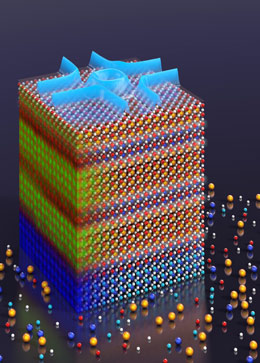Researchers at Cornell University led by Kyle Shen wanted to understand the reason behind the intriguing phenomenon in transition oxide superlattices where an addition of an extra atomic layer is enough to cause the transition from conductor to insulator.
 Artist representation of transition metal oxide superlattice. The red is manganese, yellow is lanthanum and blue is strontium. The top is a Fermi surface map which illustrates how electrons move in the material (Credit: Kyle Shen)
Artist representation of transition metal oxide superlattice. The red is manganese, yellow is lanthanum and blue is strontium. The top is a Fermi surface map which illustrates how electrons move in the material (Credit: Kyle Shen)
Transition metal oxides are materials which exhibit a host of useful properties such as superconductivity and magnetoresistance. Superlattices of transition metal oxides are artificial structures composed of stacked, one atom thick, alternating layers of different materials. These artificial structures are of significant interest owing to their sensitivity to even slight changes to their structure. The quantum interactions between the electrons in the various layers can cause the superlattice to shift between insulating and conductive state depending upon the sequence of stacking. While the striking magnetic and electronic properties exhibited by these superlattices do not have an imminent application, they may prove useful someday.
The researchers combined two techniques, namely, oxide molecular beam expitaxy and angle-resolved photoemission spectroscopy to understand the quantum mechanics in the superlattices. The team designed the superlattice from stacks of strontium manganese oxide and lanthanum manganese oxide. The superlattice was prepared by using molecular beam epitaxy, a process that is comparable to spray painting. To study the superlattices, the researchers employed angle-resolved photoemission spectroscopy. The benefit of this technique is that the sample surface is protected from contamination by air which would affect the results of the experiment. The team studied the movement of electrons and found that the key factor driving the quantum interactions was the distance between the interfaces of the stacked layers. An increase in distance between the interfaces restricts the electrons within their respective stacks which pushes the superlattice into insulator state. When the interfaces are close to each other, the resulting movement of electrons across interfaces pushes the superlattice into a metallic conductive state.